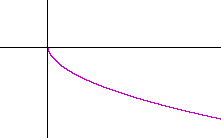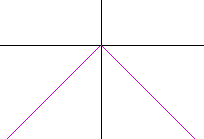15
REFLECTIONS
CONSIDER THE FIRST QUADRANT point (a, b), and let us reflect it about the y-axis. It is reflected to the second quadrant point (−a, b).
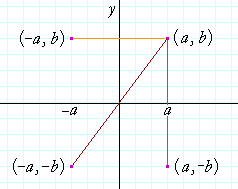
If we reflect (a, b) about the x-axis, then it is reflected to the fourth quadrant point (a, −b).
Finally, if we reflect (a, b) through the origin, then it is reflected to the third quadrant point (−a, −b). The distance from the origin to (a, b) is equal to the distance from the origin to (−a, −b).
Example 1.

Fig. 1 is the graph of the parabola
f(x) = x² − 2x − 3 = (x + 1)(x − 3).
The roots −1, 3 are the x-intercepts.
Fig. 2 is its reflection about the x-axis. Every point that was above the x-axis gets reflected to below the x-axis. And every point below the x-axis gets reflected above the x-axis. Only the roots, −1 and 3, are invariant.
Again, Fig. 1 is y = f(x). Its reflection about the x-axis is y = −f(x). Because every y-value is the negative of the original f(x).

Fig. 3 is the reflection of Fig. 1 about the y-axis. Every point that was to the right of the origin gets reflected to the left. And every point that was on the left gets reflected to the right. Every x becomes −x. Only the y-intercept is invariant. The equation of the reflection of f(x) about the y-axis is y = f(−x).
If y = f(x), then
y = f(−x) is its reflection about the y-axis,
y = −f(x) is its reflection about the x-axis.
Problem 1. Let f(x) = x² + x − 2.
a) Sketch the graph of f(x).
To see the answer, pass your mouse over the colored area.
To cover the answer again, click "Refresh" ("Reload").
x² + x − 2 = (x + 2)(x − 1). The x-intercepts are at −2 and 1.
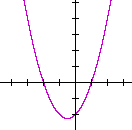
b) Write the function −f(x), and sketch its graph.
−f(x) = −(x² + x − 2) = −x² − x + 2. Its graph is the reflection of f(x) about the x-axis.
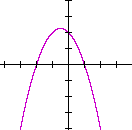
c) Write the function f(−x), and sketch its graph.
Replace each x with −x. f(−x) = x² − x − 2 = (x − 2)(x + 1). Its graph is the reflection of f(x) about the y-axis.
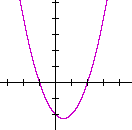
Problem 2. Let f(x) = (x + 3)(x + 1)(x − 2).
Sketch the graph of f(x), then sketch the graphs of f(−x) and −f(x).
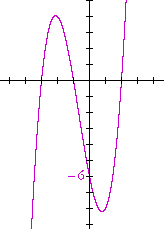
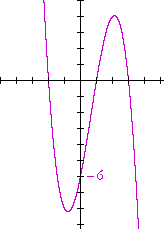
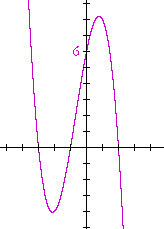
The graph on the left is f(x). The roots -- the x-intercepts -- are −3, −1, 2.
The middle graph is f(−x), which is its reflection about the y-axis.
The graph on the right is −f(x), which is its reflection about the x-axis.
Problem 3. Let f(x) = x² − 4.
Sketch the graph of f(x), then sketch the graph of f(−x).
x² − 4 = (x + 2)(x − 2).
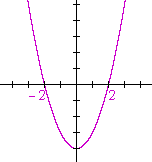
Here, the graph of f(−x) -- its reflection about the y-axis -- is equal to the graph of f(x).
Problem 4. Let f(x) = x³.
Sketch the graph of f(x), then sketch the graphs of f(−x) and −f(x).
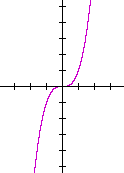
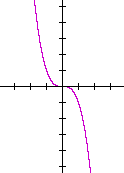
The graph on the left is f(x).
The graph on the right is f(−x), which is its reflection about the y-axis . But (−x )³ = −x³, so that
f(−x) is equal to −f(x) -- which is its reflection about the x-axis!
Example 2. Sketch the graph of y = −x² + x + 6.
Solution. It is best to consider a graph when the leading coefficient is positive. Therefore, let us call the given function −f(x):
| −f(x) | = | −x² + x + 6 |
| = | −(x² − x − 6) | |
| = | −(x + 2)(x − 3) | |
f(x), then, is (x + 2)(x − 3). Its x-intercepts are at −2 and 3. The graph we want is −f(x), which is the reflection of f(x) about the x-axis:
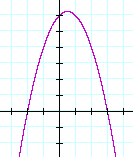
Problem 5. Sketch the graph of y = −x² − 2x + 8.
| −f(x) | = | −x² − 2x + 8 |
| = | −(x² + 2x − 8) | |
| = | −(x + 4)(x − 2) | |
Here is the graph:
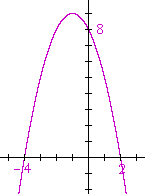
It is the reflection about the x-axis of
f(x) = x² + 2x − 8
Problem 6. Sketch the graph of y = −x3 − 2x² + x + 2.
[Hint: Call the function −f(x), then factor f(x) by grouping.]
| −f(x) | = | −x³ − 2x² + x + 2 |
| = | −(x³ + 2x² − x − 2) | |
| = | −[x²(x + 2) − (x + 2)] | |
| = | −(x² − 1)(x + 2) | |
| = | −(x + 1)(x − 1)(x + 2) | |
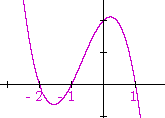
The graph is the reflection about the x-axis of
f(x) = (x + 2)(x + 1)(x − 1)
Problem 7. Sketch the graph of y = −![]() .
.
Problem 8. Sketch the graph of y = −|x|.
www.proyectosalonhogar.com

